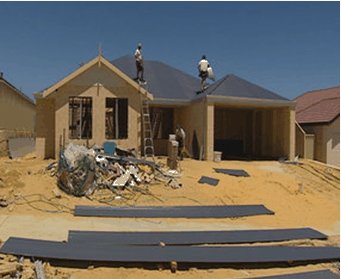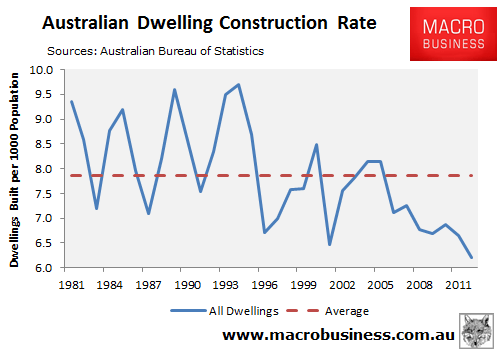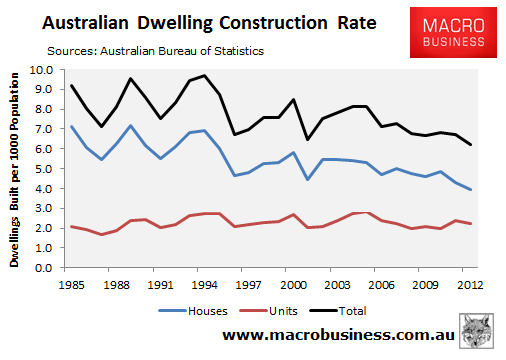
The Housing Industry Association (HIA) has today issued a media release looking at the state of dwelling construction across Australia prior to tommorow’s data on March quarter dwelling commencements by the Australian Bureau of Statistics.
According to the HIA, although dwelling construction appears to be experiencing a small cyclical recovery, it is in structural decline, having trended down strongly since the mid-2000s. And in order for the recovery to last beyond 2013, a range of supply-side reforms are required:
…there are encouraging, but not yet compelling signs of a new home building recovery.
In considering a range of leading indicators for new housing starts, it is pleasing to find that a majority point to a short term increase. Eight of the twelve leading indicators we have considered signal an upward direction for housing starts, including land sales, detached house approvals, and new detached house sales.
Even allowing for some further upward revision from the ABS, the 2012 base for housing starts is relatively weak and follows a significant decline in 2011. Consequently it is important that any recovery in 2013 is of a sizeable magnitude. In 2012 the number of housing starts fell in Victoria, South Australia, Tasmania, and the Australian Capital Territory, and was flat in New South Wales. Starts were at historically very low levels last year in New South Wales, Queensland, South Australia, and Tasmania, and were at their second lowest level in a decade in Western Australia following what was a decade low in 2011. Therefore, a broad-based geographical recovery will also be important to observe.
The release of housing starts data for the March 2013 quarter won’t provide all the answers about the magnitude and breadth of a new home building recovery, but will provide crucial guidance.
The other key factor to consider is the sustainability of a new home building recovery. Housing starts have fallen in six of the last ten years and been essentially flat in a further two of these years. The number of housing starts per additional household in Australia has been trending down since mid-2004.
Super low interest rates won’t last forever nor will they deliver a sustainable recovery in new housing on their own. The new home building sector faces an unusually large number of headwinds in aiming to extend any recovery beyond just 2013. Household deleveraging, tight credit on both the demand but especially the supply side, lack of readily available land, high and inefficient taxation relative to existing property and the broader economy, and hefty regulatory costs are prominent examples.
New housing is a sector of the Australian economy in dire need of considerable reform, as clearly evidenced by the results from the three reports HIA has commissioned from the Centre for International Economics regarding the taxation of housing and the importance of housing to the wider economy.
New housing is inherently a cyclical sector within which an overall downward trend has been evident for many years now. Any contemporary recovery needs to last for longer than the four quarters over which the last (stimulus-driven) recovery occurred in 2009/10. That won’t happen unless some path of reform is embarked upon.
As noted on Friday, despite the massive surge in house prices since the mid-1990s, the rate of dwelling construction in Australia has trended downwards, hitting a 30-year low in 2012 of just 6.2 dwellings per 1000 head of population, well below the average construction rate of 7.9 over the last 30-years:

The slump in overall dwelling construction has been driven by the detached house segment, whereas apartment cosntruction has remained relatively stable per head of population over the past 30 years:

As noted on many occassions, Australian dwelling construction will remain in the doldrums as long as land prices remain ridiculously high, pricing new homes beyond what many buyers can afford or are willing to pay. Short-term stimulus, such as low interest rates and grants, can provide a short-term bounce, but as long as land prices remain elevated, the recovery will fade soon after, thwarting the RBA’s plan for dwelling construction to fill the void left as the mining boom unwinds.
A sustainable construction recovery will only be achieved if the impediments to affordable supply: land availability, restrictive planning, taxation, and infrastructure funding and provision, are tackled head-on.

